-
THE LAST ITALIAN COWBOYS/GLI ULTIMI BUTTERI (Walter Bencini 2018)
WALTER BENCINI: THE LAST ITALIAN COWBOYS/GLI ULTIMI BUTTERI (2018)

"Si ruba cogli occhi" (You steal with the eyes)
The guy tells us right away: they are not Italian "cowboys." They are "butteri." In Argentina (and other South American countries) there are the "gauchos." In Hungary there are the "zigos." In America there are the "cowboys." And in Italy there are the "butteri." E basta.
Once in a while a documentary comes along about something special and unique that is beautifully made, and this is such a documentary. This is an absolutely stunning documentary, and it is not yet listed on IMDb. It is as beautiful as it is filled with specific information, so it is richly informative and also aesthetically satisfying and thought provoking. It is not the new kind of intensive observation like those of Harvard's Sensory Ethnography Lab (Sweetgrass, Foreign Parts, People's Park, Leviathan), but of the more conventional kind, and there is much dependence on talking heads and voiceover narration by participants. But the tapestry is rich and the mood at times is enchanting, thanks to continually beautiful visuals of cattle, horses, men, and varied landscape, and the emerging sense of a way of life that is as tough-mindedly practical as it is moral and aesthetic.
Alberese, in the Tuscan Maremma, is home to the last three remaining butteri, heroic men who still rear cattle in the wild, living examples of the possibility of redemption between humans and nature. They speak of the legends, Augusto Imperiali, Italo Molinari, and Mario Petrucci. The eyes of these men and their animals reflect the feeling they have of living a life with meaning, a life that they will never give up. Two young men have joined the group to learn this traditional craft, a tough job that few can do. Only one of them will make it. The future of this ancient world will lie in his hands.
When we think of cowboys we think of vast western lands, and of course the Wild West, the frontier, Indians. The butteri reside in the Maremma region, a coastal area of western central Italy bordering the Tyrrhenian Sea. It was adapted and tamed in the past as a place where men could cultivate with animals and live in harmony with them (It was a malarial region, but that was ended by the Second World War.) It includes much of south-western Tuscany and part of northern Lazio. It is a civilized region, and a beautiful one, to which Walter Bencini's camera does full justice. The men we meet are civilized and dedicated, responsible raisers of cattle who, we learn early on, make a point of knowing the names of all the cattle and knowing the names of their mothers and grandmothers, and can recognize them by the contours of their horns, or their stride. Ever see that talked about in a Western?
The young ones still hanker after it. The special, closed world. When the older ones say "Si ruba cogli occhi," you steal with the eyes, they refer to the fact that the old timers would never answer questions, you just had to observe them. An old timer provides background, how the region was developed under fascism, how most of the butteri then came from the Veneto region. This is an exclusive, macho world, whose toughness and pride are reinforced by making it hard to enter. An old timer scoffs at the idea of accepting a woman, because he thinks the work of today's butteri has become too physically demanding.
Not only are the horses and the cattle and the land beautiful, but the men have a style that would make Ralph Lauren green with envy, a seasoned, unpretentious but inimitable elegance. They wear brimmed hats, but not the cowboy kind. They wear boots and leather chaps and vests, that look like a million dollars, or thousands of dollars of goods from Filson, the pricy Seattle outdoor and work outfitters.
"The passion you have for this work is also a passion for these animals," says a buttero, and they speak of the satisfaction they take in training a horse, while another says his greatest love has turned out to be for the cattle. The men are uncomplicated, perhaps, but they are articulate in expressing the significance of their interaction with animals as the essential joy of their profession.
Bencini divides the film into seasons, and also uses aerial drone shots for a new look at herding, both diagrammatic and beautiful. As time goes on, we also learn that the work of the buttero done at this farm is harder than ever, because they do more of the tasks of the farm, and don't just ride around on their horses all day as they did in the old days. The work requires absolute love and determination. Like being a classical musician, it requires that you start at it very young and that you have a natural gift for it combined with a passion that never lets up. And in this case, the salary isn't much. So when they put out a call for applicants, it's not 120 who turn up but 12, and of those only a couple are real possibilities. Through the course of the film, which was shot over a period of several years, we see only three full-fledged butteri and two younger aspirants, one of whom withdraws from the work after two years.
This way of working with the animals, horses and cattle, out in nature, is what in principle everybody wants: it's natural, organic, slow food, all the good stuff. But in the distance faintly we hear the rumbling of machines, and the most experienced buttero of the farm who is the most authoritative narrator, and has the longest memory, can also anticipate the time in his children's lives that this way of life will fade away. With that Bencini's image itself of butteri on their horses managing the cattle, it too fades away. A fitting ending for a tough-minded but romantic film.
The Last Italian Cowboys/Gli ultimi butteri, 95 mins., was released 18 Jun., 2018, distributed by Istituto Luce Cinecittà and Berta Film. Screened for this review as part of the New Italian Cinema series in San Francisco, where it shows Sat. 1 Dec. 2018 at 3:45 p.m.
Last edited by Chris Knipp; 11-25-2018 at 10:53 PM.
-
THE LAST PROSECCO/FINCHÉ C'È PROSECCO C'È SPERANZA (Antonio Padovan 2017)
ANTONIO PADOVAN: THE LAST PROSECCO/FINCHÉ C'È PROSECCO C'È SPERANZA (2017)

GIUSEPPE BATTESTON IN THE LAST PROSECCO
Sleuth du terroir
Somewhere along the way I lost track of the various narrative threads of Antonio Padovan’s Italian provincial thriller/mystery. But with this kind of mystery, what counts is the atmosphere, and the main characters, aand these are all pretty good. The winemaker of noble birth whose demise begins the action, Count Desiderio Ancillotto (Rade Serbedzija), has a rough elegance that is irresistible. We know he is right, and cool, whatever he is saying or thinking, and we know his anger is justified. He disappears early on, but his spirit presides over the action that follows.
The count's death seems obviously self-inflicted. We see him sit on a tombstone and quaff a bottle of his own prosecco and wash down a bottle full of pills. But soon there are a couple of murders. Authorities tell us the Italian white wine called prosecco can be spumante (sparkling), frizzante (semi-sparkling), or tranquillo (still, or literally "quiet"). For the Count it winds up being very tranquillo indeed.
Stucky, the fledgling inspector on the case, as played by the very large (in height and girth) and currently very busy Italian actor Giuseppe Battiston, is the kind of guy you want to follow around. He is a giant teddy bear of a man, and his physicality inspires confidence, while his uncertainty as a detective awakens our sympathies. He is Persian-Italian, and watever that means, it's part of the layered complexity of a story that's meant to tease and perplex us.
The other star of the film is the rolling hills of Valdobbiadene, in the Veneto, a region, like so many in Italy, so photogenic it makes you wonder why you stopped going over every fall.
The Last Prosecco has evil polluters, political manipulation, a crazy man in a graveyard scraping off rust and talking to the dead. He may know someting. There are three women, the count's mistress (Silvia D’Amico, who will be demoted to prostitute in Hotel Gagarin), his long-absent daughter (Liz Solari), who's been living in South America, and his bossy housekeeper (Giselle Burinato). When the housekeeper orders Stucky to get out, and he doesn't, and stays to talk to the daughter, we realize he has some authority, after all. This is an environmental drama whose resonance is considerably enhanced by the beauty of the local location where the popular prosecco, sometimes a substitute for champagne and also used in the Bellini and spritz cocktails, is made. This is Padovan's first feature after a series of prize-winning shorts. He was schooled in film in New York, and made a short documentary about the tidal wave and earthquake in Japan. He returned to his native Italy to make this film in 2016.
The Last Prosecco/Finché c'è prosecco c'è speranza ("As long as there is prosecco there is hope"), 101 mins., debuted in Italy in Oct. 2017. Screened for this review as part of the New Italian Cinema series in San Francisco, where it plays at the Vogue Theater Sat., 1 Dec. at 6:00 p.m.
Last edited by Chris Knipp; 11-03-2018 at 05:32 PM.
-
HOTEL GAGARIN (Simone Spada 2017)
SIMONE SPADA: HOTEL GAGARIN (2017)
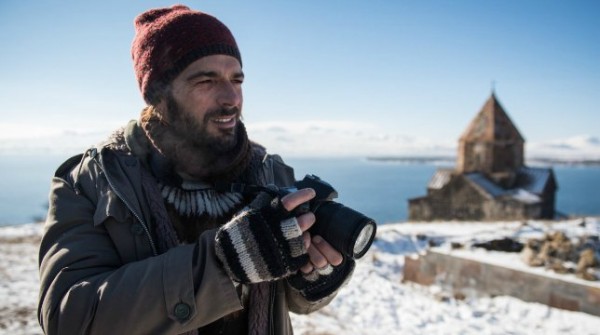
LUCA ARGENTERO IN HOTEL GAGARIN
An Armenian dream factory
Hotel Gagarin, an ensemble piece, is a movie road movie. It concerns the ostensible making of a film that requires a group of (mostly) Italians to go to Armenia, in the southern Caucasus, in wintertime. But it's a scam, filmed as a good-humored, slightly bawdy joke, that turns serious, and risks a delicate sentimentality.
The tale begins with a disreputable producer called Franco Paradiso (Tommaso Ragno), who assembles a group of suckers for a movie he never intends to have made, simply to raise European grant money and abscond with it. Whether all this makes sense is secondary. Simone Spada, the director of Hotel Gagarin, is mainly concerned to lead us pleasurably from one scene to the next and fill each of them with a colorful character and a dream.
After Paradiso, the next individual we meet, a jovial giant of a man, is a naive professor of history and cinema appreciation, Niccola (the ample-bodied Giuseppe Battiston, who recently played the quizzical detective in The Last Prosecco). We see him lecturing a class of arrogant know-nothings, whose interest in and respect for cinema is nonexistent, when he suddenly receives a blunt call from Paradiso saying he's going to produce his scenario and that work on it starts tomorrow, and he'd better show up. Well, this has long been Nicola's dream. What has he got to lose?
To lead his fake "crew," Paradiso calls an Italianized Russian "events planner," Valeria (Czech-born Barbora Bobulova, who has a raft of good Italian films to her credit). No stranger to Paradiso's crooked dealings, she is on on the scam. She will be his ally and get a substantial cut for leading the scam in Armedia, or at least he allows her to believe this. He finds a real photographer called Sergio (the handsome Luca Argentero), who's on the run from the Mob for a bad debt and will accept any excuse to disappear for a while. Off the streets of Rome he grabs a prostitute, Patrizia (Silvia D’Amico), who he promises will play the lead. He picks up Elio (Claudio Amendola), an electrician with no movie experience, and a handful of others.
The naive Niccola is too excited at the prospect of having his scenario made into a film to question the credentials of any of these dubious characters, though the smallness of the crew does worry him. There is also a drunken local "guide" called Aram (Hovhannes Azoyan), a goofy mime, like Harpo Marx, and a few others. They all wind up at a tall, wide old hotel on a barren hill, the Gagarin, named after the Cosmonaut, Yuri, and placed the middle of a snowy vastness, a setting Wes Anderson might have liked.
This promises to go very badly for the poor dupes out in the chilly Caucasus - especially when it turns out there is a war going on: the Azerbaijani army has been firing on the Nagorno-Karabakh. And you know how it is when they get at each other. The visiting "filmmakers" are forced to remain in Hotel Gagarin: moving around outside, for the moment, would be too dangerous. Phone contact with the outside is also cut off.
And then the villagers from nearby come to them, hearing word that great Italian cinematographers are on hand, and wanting to have their own fantasies put on film. These include a white-bearded geezer (Ara Sargsyan) who always wanted to be Yuri Gagarin. The motley crew obliges, participating in games and pantomime, eventually faking filmmaking in a way that, at least for Nicola, who becomes the director, is satisfying to the imagination for him too. When eventually an emergency unit comes from the Italian embassy with a plane to rescue them, the satisfaction is bittersweet. For a while we, the viewers, participate in their fantasy, though its realization depends on a lot of our good will and a lot of Simone Spada's montages. Not everyone goes back, not Patrizia, who likes it better here, and goes off on a horse with Aram. Elio, whose role as electrician is much grander here than it was back home, may not be inclined to leave either. Maybe the De Sica and Zavattini of Miracolo a Milano would have understood this scatterbrained, genial fantasy. The whimsical end credits are choice. The scenario was coscripted by Spada and Lorenzo Rossi Espagnet.
Hotel Gagarin, 93 mins, released in Italy 24 May 2018. It was screened for this review as part of the 2018 San Francisco New Italian Cinema series, where it is scheduled to show at the Vogue Theater Sat., 1 Dec. 2018 at 8:15 p.m.
Last edited by Chris Knipp; 11-28-2018 at 01:42 AM.
-
MANUEL (Dino Albertini 2017)
DINO ALBERTINI: MANUEL (2017)
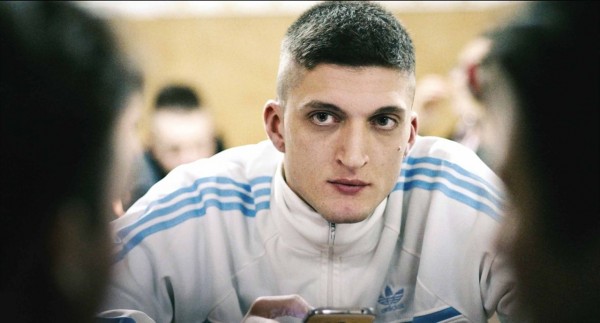
ANDREA LATTANZI IN MANUEL
A gentle giant of a "a rough authentic heroic fragility"*
Forty-four-year-old documentary filmmaker, musician and a photographer Dino Albertini has made a strong, austere first feature in a neorealist, vérité style focused on a preternaturally grownup 18-year-old released from a foster care center, Manuel (assured newcomer Andrea Latanzi, who carries the film with firm conviction and a cool, focused intensity). Manuel must go to live in his mother's flat and establish his credibility as a responsible adult there so his mother Veronica (Francesca Antonelli), who is in prison, may be released to house arrest. The film moves with a sharp, harsh rhythm in the cutting by editor Sarah McTeigue. The music is mostly the cry of voices, the distant sound of trains. The tall Latanzi is a lithe young everyman of heroic composure. He grouses to the foster home supervisors and the opening shows the no-nonsense life there, but also the warmth. A gardener is a former inmate who never left who says a sweet goodbye, and the lay brother who takes him to the station jumps out to hug him.
Albertini interpolates a vivid interlude before Manuel gets to the apartment. There's no train, it's suspended for hours due to an accident. In the interim Manuel helps a mute, impoverished man with his motor-cart and gets a ride to his tiny dwelling, where a pretty young woman comes who provides her own social services to him. She is an actress preparing an audition and later Manuel helps her rehearse lines from Truffaut's Stolen Kisses. It is if she is seducing him. But Manuel is not to be distracted from his goal, and bam! we're on the train, which takes him to a trio of grim high-rises like the Paris banlieu. This is where he's going to live. He has to track down the manager at a tango class. The place is by the shoreline, but you can't see the water from the little flat, which is a total wreck. He must begin by gathering up and throwing out.
When Manuel has gotten the job, braved various temptations and opportunities any 18-year-old boy would welcome, when the social worker has examined him and the flat and the hearing for his mother with the lawyer has been endured and the house arrest release has been guaranteed in one week's time, and Manuel is on his way back to the flat, he can finally have a panic attack and break down in uncontrollable sobs. He has accomplished the impossible and he will go on to face the difficult and unlikely with stoicism. It's a virtuoso performance by the young Latanzi, but it feels like living, not acting and Albertini's austere style has never seemed showing and always served the action. Hardly a fun watch, but an impressive film that promises a one-person neorealist revival by this very serious and committed filmmaker.
With Latanzi in the cast are Francesca Antonelli, Giulia Elettra Gorietti, and Renato Scarpa. The screenplay is by Albertini with Simone Ranucci; the cinematographer is Giuseppe Maio. Albertini began with a documentary, La Repubblica dei Ragazzi, about the development of a group foster home, the one we see in the opening minutes, based on months of careful observation.
Manuel, 97 mins., debuted at Venice (see Albertini's note written then), and was a triple winner at the Montpellier Mediterranean Film Festival (Best Film, Critics' Prize, and Student Jury Prize). After a positive reception in the Rencontres Cinématographiques section at Cannes, it opened theatrically in Paris with the title Il filglio, Manuel 7 Mar. 2018 and was extensively reviewed with moderately positive results (AlloCiné 3.5). French critics praised Latanzi's "superb" interpretation which gave the whole, despite its unsurprising trajectory, "a powerful emotional density." L'Humanité noted that "Pathos is eschewed throughout, the extraneous eliminated," the filmmaker's documentary experience contributing to his "confidence in the power of the real." Cahiers du Cinéma foresaw a "positive future for its maker," and Les Inrockuptibles called Manuel "A 'popular' film in the best sense, i.e. one that sees its characters of the people, free-standing and upright in their dignity." The French can understand this film's style. It evokes the Dardennes, even Bresson. It also refers explicitly to Truffaut and it's been said Latanzi/Manuel is Albertino's Antoine Doinel. But this is nonetheless a film that, like the looks of its astonishing young star, is deeply Italian.
Manuel was screened for this review as part of the 2018 San Franisco New Italian Cinema series, where it shows Sun. 2 Dec. at 12 p.m.
____________
*"Una ruvida eroica autentica fragilità" (Fabrizio Tassi, Cineforum).
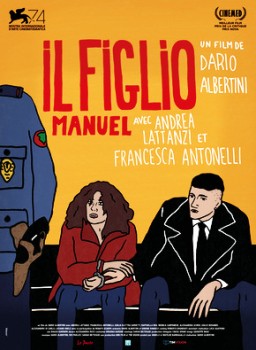
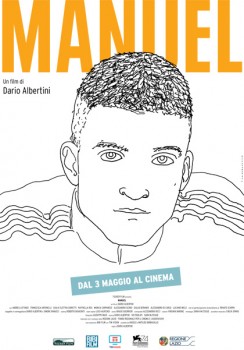
FRENCH AND ITALIAN POSTERS FOR THE FILM
Last edited by Chris Knipp; 11-28-2018 at 01:44 AM.
-
BOYS CRY/LA TERRA DELL'ABBASTANZA (Damiano and Fabio D'Innocenzo 2018)
DAMIANO AND FABIO D'INNOCENZO: BOYS CRY/LA TERRA DELL'ABBASTANZA (2018)
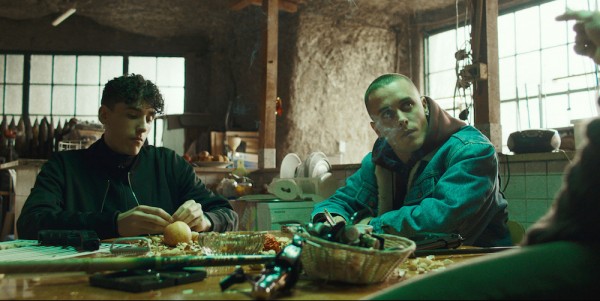
ANDREA CARPENZANO AND MATTEO OLIVETTI IN BOYS CRY
Such great luck
Two young men, childhood friends, Mirko and Manolo, live in a bad suburb of Rome with their single parents. They are in restaurant trade school and delivering pizzas, and driving around one night with Mirko at the wheel, hit and kill a man. They flee without thinking and are terrified. Manolo takes the problem to his unscrupulous dad (Max Tortora). He comes back next day with great news: the guy they killed was a police informer and killing him puts them on the good side of a gang. Before long, though Manolo tries to muscle Mirko out at first, the two best friends are together as low-level assistants. They kill people. They maintain prostitutes on the street; Mirko does, anyway. They help out with drug production (or observe it). There is talk of selling 15-year-old girls.
Supported by his low-life gangster wannabe dad, Manolo seems the most guilt-free. Mirko (the actor has big wide frightened blue eyes) is troubled all the time, gets on badly with his mother (Milena Mancini) and drives away his girlfriend (Michela De Rossi). (More focus is on Mirko throughout.) The D'Innocenzo brothers, whose debut this is, lay it all out with smooth rhythm. Their primary actors (especially Matteo Olivetti in the main role) are fresh and convincing. The film seems to take a page from Matteo Garrone and this could be a chapter from his celebrated but grim Gomorrah and part of a new school of more naturalistic and even sociological gangster film that's emerged in Italy.
But how do we take this? In his Variety review Jay Weissberg is troubled: "While the directors refuse to sensationalize the violence," he writes, "they troublingly attempt to accord sympathy to two characters whose moral compasses are patently beyond repair." Writing in Hollywood Reporter , Boyd van Hoeij is merely impressed. "What makes the film so fascinating to watch," he says, "is that the psychology of the boys keeps bubbling to the surface organically, making it easy for audiences to understand the thought processes behind their (frequently not advisable) actions. And, of course, there’s the irony that to digest the fact they killed an innocent man, they turn to killing more men — except now they are not always that innocent." Yes, there is that irony. Watching this film makes one feel dirty - and unenlightened. Perhaps that is intentional.
The best irony comes when two gang bosses discuss sending Mirko and Manolo in to kill a bigger shot, a threat to the clan's authority (before they've killed only the infame, the "grass," the "informer," and Moroccans who owed money), and it turns out the bosses find the boys shockingly amoral. "Those two don't care about anything!" Even in the gangster world their values make them outsiders - who don't matter, because they came in from nowhere, with an eagerness that was suspect. This dialogue, like the talk of the boys, is overly explicit. This film doesn't like gray areas. It hasn't the time. It's not a gangster epic, just a series of vignettes.
Filmmaker brothers Damiano D'Innocenzo and Fabio D'Innocenzo spent their childhoods on the outskirts of Rome painting, writing poems, and taking photographs, and in this promising feature film debut indeed show an excellent sense of the cinematic medium. As van Hoeij notes, some counterintuitive shots work well, particularly a long, slow distant shot of the desolate area of shacks where the boys are going to have to move in for the kill, perhaps the most memorable moment of the film. Every moment is harsh, vivid, and intense. Meaningful is another matter. A second viewing did not leave me feeling any the wiser, but the scenes still seemed realistic, if perhaps a little glib and, as hinted, over-explicit.
Boys Cry/La terra dell'abbastanza, 94 mins., debuted in the Panorama section of the Feb. 2018 Berlinale, also showing at Genoa, Edera, Chicago, and Miami. It won five Italian festival awards and was included in Open Roads: New Italian Cinema at Lincoln Center May 2018. Screened for this review as part of the San Francisco New Italian Cinema series, where it shows 2 Dec. 2018 at 2:15 p.m.
Last edited by Chris Knipp; 05-27-2023 at 10:51 PM.
-
EASY/UN VIAGGIO FACILE FACILE (Andrea Magnani 2017)
ANDREA MAGNANI: EASY/UN VIAGGIO FACILE FACILE (2017)
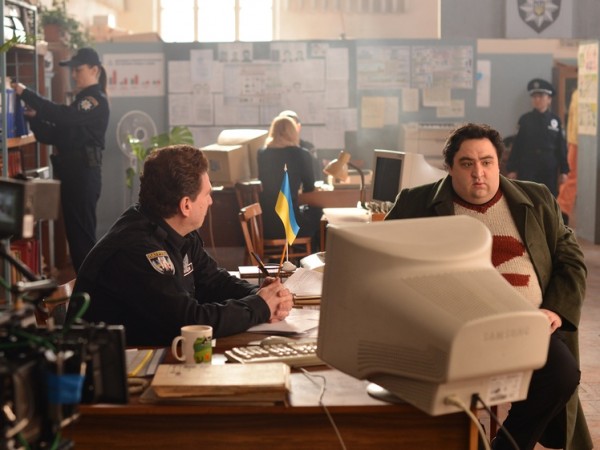
NICOLA NOCELLA (RIGHT) IN EASY
A droll road movie
Isidoro (Nicola Nocella) is known as Easy but his life isn't that, not for him. His career as a go-kart racer has ended, ostensibly because he has grown too fat. But he admits later another cause that may have to do with an addiction to unspecified drugs. And easy is depressed, or rather very glum. Easy, and the events that follow, would be very much at home in a film by the Finnish director Aki Kaurismäki. Depression becomes a kind of cheerfulness, gloom a kind of hope. When all other lights go out, that little candle remains inextinguishable.
And like all great travelers, Easy is granted a mission. A Ukrainian worker called Taras dies on a building project run by Easy's brother Filo, and Filo gives Easy something to do: drive a hearse with Taras' coffin to his home in Ukraine, in the Carpathians. He is given an apple, a nice new hearse, a smart phone set to translate from Italian to Hungarian, and a GPS programmed to direct him the whole way. And off he goes. A simple task.
Not so simple. In fact a journey of almost epic frustrations, but also of much drollery. The director, Andrea Magnani, who hails from Rimini, the birthplace of Fellini, and now divides his time between Trieste and Rome, makes fine use of eccentric locations and peculiar people. As soon as Easy gets through Hungary into Ukraine, and gets lost, while he is on the phone talking to his brother, a car drives up on the highway - Easy has gone out in a field to get phone reception - and drives away the hearse. The coffin they leave.
Easy proves remarkably steadfast in sticking with the coffin and his task. He will be on a horse-drawn cart piloted by an aged, bearded, somnolent geezer; floating down a river astride the wooden box; driving a tractor with the box mounted in front. He will pull it uphill on wheels.
This is partly, but not wholly, a journey of transformation. When border guards complain that Easy's passport photo doesn't show him in his current big bushy beard, he steps inside the gents' and shaves it off. Somehow Easy's girth protects and sustains him. It is as if he has a lot of layers to protect him. If some of them away, he's still inside. But, "Wherever you go, there you are." It is always Easy and it is never Easy.
In the end, high up in the Carpathians, he reaches the deceased Ukrainian worker's proper family with his coffin and they provide him with a proper burial. Now what do I do? our hero asks. Fade to black.
Easy was nominated for Best Actor and Best New Director at the David di Donatello Awards and won the Jury Prize for Best Actor at the Monte Carlo Comedy Film Festival.
Andrea Magnani, born in Rimini in 1971, lives in Rome and Trieste, and has a degree in political science. He was a finalist for the Solinas Prize in 2002 and was selected for the first edition of the Berlinale Talent Campus. Magnani writes for cinema and television. He has directed several documentaries, including Caffè Trieste (2009), awarded Best Documentary at the Trieste Film Festival (Zone di Cinema), and Watching Me is Enough (Basta guardarmi, 2006), selected for the World Film Festival in Montreal and the Giffoni Film Festival, among others. He is writer and director, along with Davide Del Degan, of Paradise, a co-production between Italy and Slovenia, in theaters in 2018. For television, he is the writer of the series Inspector Coliandro. Easy (Un viaggio facile facile) is his first feature film.
Easy/Un viaggio facile facile, debuted at Locarno Aug. 2017, also showing at (logically) Helsinki and Zurich. It was screened for this review as part of the 2018 San Francisco New Italian Cinema series, showing 4:30 p.m. Sun. 2 Dec. 2018. Easy won the NICE City of Florence Award for Best Dramatic Feature by a First or Second Time Director at the San Francisco event.
By a First or Second Time Director
Last edited by Chris Knipp; 12-06-2018 at 09:22 AM.
-
THE CALL/LA CONVOCAZIONE (Enrico Maisto 2017)
ENRICO MAISTO: THE CALL/LA CONVOCAZIONE (2017)
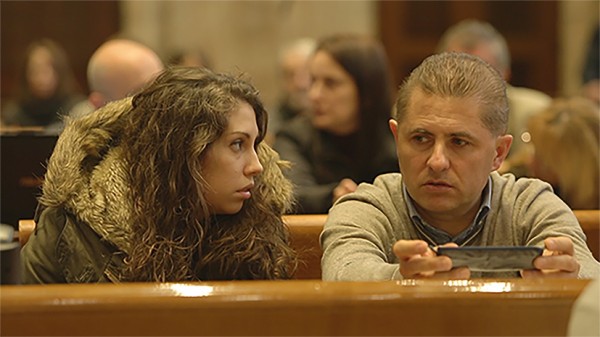
POTENTIAL JURORS WAITING IN THE CALL/LA CONFOCAZIONE
Jury duty, Italian style
In Italy, as in America, there is jury duty. It begins with the selection of the jurors. This is the process mainly focused on in Enrico Maisto's short documentary. We are in Milan, the Assize Court of Appeal. They deal with big stuff, murder, mafia, terrorist acts. There are two judges, and the chosen jurors, actually known as giudici popolari, "popular judges," are six, and sit beside them, three on each side, and confer with the judges, arriving at decisions collectively.
Someone remarks that the courtroom style, no doubt with the mosaic mural decorations in mind, are an example of the grandiose look of the fascists that appealed to Mussolini. Couldn't it just be the Italian manner? Italian public spaces tend to be grand and widely proportioned, and such is the case of the Italian Court of Assizes of Milan. Anyway, here they are all are, called to do their civic duty, serve justice, if they can, and maybe have an interesting time. This is their emotional first contact. Someone refers to "Sironi," Luca Sironi, whose photo-essay showing the ruthless architecture of deserted Italian courtrooms is, apparently, well-known.
The film spies on some of the sixty assembled prospective jurors skillfully. The camera, unnoticed, is tight on faces of the men and women, and the microphone, unseen, gathers up a seamless blend of interesting snatches of their conversations. There are a host of feelings and thoughts. At first there is grousing about time lost from work, even of how hard it was to find the court. There are fears, that they may not be up to the task, that their involvement may put their lives in jeopardy. The latter the female judge conducting proceedings doesn't totally allay. First she says the accused are behind bars, so can't do them any harm. Then she admits that many of the accused are linked with the mafia and jokes that if there were danger, the court would all be dead by now. Some are concerned at losing money. One well-dressed gentleman says he has lost fifteen hundred euros just by being away from work this day, though, he adds later, with a smile, luckily the business can function without his presence. Others talk about how essential work, or the lack of it, will determine their serving, or not - or the caring for a sick mother. One lady, with bushy gray hair, says she does not work, and she can do the juror's job, and would like to.
We don't know how the "popular judges" are chosen, but the comment of a judge about this film (an approving one) notes that at this opening encounter it's important to learn if the candidates are disposed to "administer justice with passion (and hence, commitment), or with indifference and annoyance." Part of the annoyance might come from the fact that in Italy the potential jurors are summoned at home not by a postcard, as in America, but by a home visit from the carabinieri.
In time, conversation turns to growing enthusiasm for the task, doing one's civic duty, learning about the law, just hearing interesting stuff. Ladies also talk about their future plans, when they are not working, other jobs they'd do. Volunteer in a prison? No, the bushy haired lady , now a chosen juror, says, she'd rather work in a library.
It's repeatedly made clear that only the jurors' "common sense" is required, no special knowledge. On the other hand, they may have to read many pages of court documents about previous trials now being reassessed. And by the way, however long individual trials run, jurors serve for three months. One gets a sense that a more unified culture and a higher level of education is assumed here, and that's evidenced by the dialogue we witness. The chosen jurors and alternates are also each called upon to read aloud what sounds like a pretty sophisticated statement of their pledged duties and responsibilities - ending in a promise of confidentiality.
What's not clear is the way the trial will proceed, and even the specific details of jury selection. In the courtrooms where I've been called to jury duty, you have the judge, the jury, and the lawyers for the court and the defense. Each potential juror is asked basic questions pertaining to his or her background and relation to the case and those involved, and the lawyers are allowed a certain number of dismissals. Here, the potential jurors are called away to another room where the questioning goes on unseen by the rest of those called in, or by us. Presumably only the two judges make the choices, since we see no lawyers.
A review of the other documentary shown at the New Italian Cinema series, about a government office's bureaucratic functioning, compares it to a film by Frederick Wiseman, which, it says, "captures the gears and mechanisms of the institutions," whereas the Italian one "seems like a theater of the absurd." Well, of course, we realize, the reach and influence of Wiseman's prodigious oeuvre must be global, and we can feel it in how these two films are constructed.. But what limits this one is that its camera doesn't move as Wiseman's would to the other rooms to observe other parts, even the most trivial, of the court's work, not to mention the crucial one of jury selection . But within its limitations, Maisto's documentary is humane and fascinating, and a civic lesson too.
The "convocation" filmed here took place in 2015. Rather astonishingly, the end notes tell us, the jurors called up met for the last time "to pronounce the sentence 22 July 2015 for the massacre of Brescia that took place in the Piazza della Loggia 28 May 1974." This was a reconsideration of a previous case that was reconsidered before, and the charges dismissed. This time Carlo Maria Maggi, leader of the far right organization Ordine Nuovo, and Maurizio Monte, collaborator of the secret services, were sentenced to life imprisonment. It was announced to the jurors at the outset that new testimony from a "pentito" (a "Years of Lead" terrorist who turned state's witness) was going to be heard in the 1974 bombing in the main square of the city of Brescia. Big stuff - forty years later.
The Call/La convocazione, 56 mins., showed at Milan, and in documentary festivals in Tremblay-en-France, Toronto (Hot Docs), Linz, Florence, Budapest, Munich, Široki Brijeg (Bosnia), and at DMZ Docs, South Korea. Theatrical release in Italy began 15 Jan. 2018. It was screened for this review as part of the 2018 San Francisco New Italian Cinema series, where it showed at 7:15 p.m. 2 Dec.
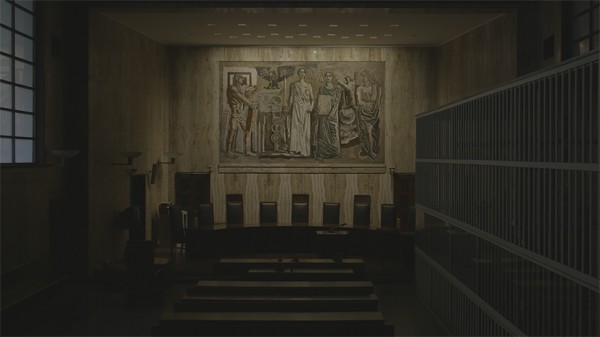
THE MILAN ASSIZES COURTROOM, DARK; RIGHT, THE CAGE WHERE ACCUSED ARE HELD
Last edited by Chris Knipp; 11-28-2018 at 06:14 PM.
 Posting Permissions
Posting Permissions
- You may not post new threads
- You may not post replies
- You may not post attachments
- You may not edit your posts
-
Forum Rules





 Reply With Quote
Reply With Quote









Bookmarks